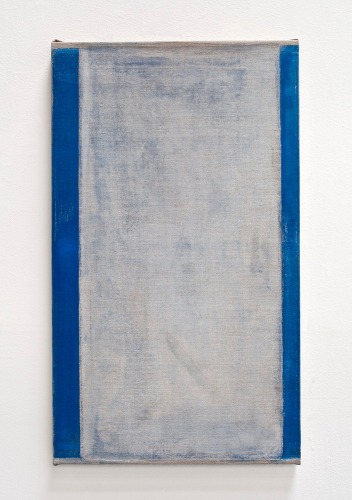
Cold July, 2014, distemper on linen, 25 1/2 x 16 1/2 inches (64.8 x 41.9 cm)
John Zurier
By David Ebony
May 2015
California-based painter John Zurier has developed a kind of delicately nuanced abstraction that seems at once ethereal and resolute. He has been showing his spare, near-monochrome compositions since the 1980s, and he now commands a distinctive, though rather narrow, path situated somewhere between the ideals of Minimalism—as found in Robert Ryman’s work—and the nonchalant look of certain recent abstraction that some critics refer to as provisional painting: for instance, the canvases of Michael Krebber.
For this engaging show, “West of the Future,” Zurier presented 14 works on linen, created with oil, distemper or both over the past two years. They vary in size from about 2 to 7 feet high and up to 4 feet wide. Using feathery brushstrokes to make thin, overlapping washes in analogous colors, he achieves an impressive range of spatial and emotional depth in each work. Most of the paintings on view were inspired by Zurier’s recent travels to Iceland, as evident in the way they evoke the country’s light, sky, fog and ice. Despite the landscape references in the work, Zurier does not rely on descriptive elements, and the images remain rigorously abstract.
Where Time Sleeps is large and has a deceptively simple composition. Zurier disrupts a chalky gray-white surface with five irregular white lines that seem to hover in thin air. The work’s overall comportment is silent and austere. Warmer in tone and more intimate in scale, Héradsdalur 19 has a faint magenta ground punctuated here and there by several tiny irregular geometric shapes in ocher. This work, like many of the others on view, appears as a nod to Color Field painting, albeit minus the heroic scale usually associated with that style.
One of the largest and best works in the show, Summer Still (The Same Shadow), features an expansive field of pale cobalt blue made of thin layers of pigment. The velvety matte surface and the translucent markings have the look of watercolor. With clusters of scumbled brushstrokes, Zurier suggests subtle movement toward the right. The image conveys the quiet rivulets of a tidal pool or shifting cirrus clouds, but landscape evocations are kept in check by a compositional device that Zurier frequently uses: narrow bands often appearing near the edges. Here, two vertical dark blue lines on either side descend from the top of the canvas and stop at the middle. Such marks have the effect of gently coaxing the viewer away from a pastoral reverie toward a more empirical meditation on painting itself—its phenomenological attributes in terms of color, form, texture and unfathomable space. This work’s impact, like that of just about every painting in the show, is unexpected and formidable.